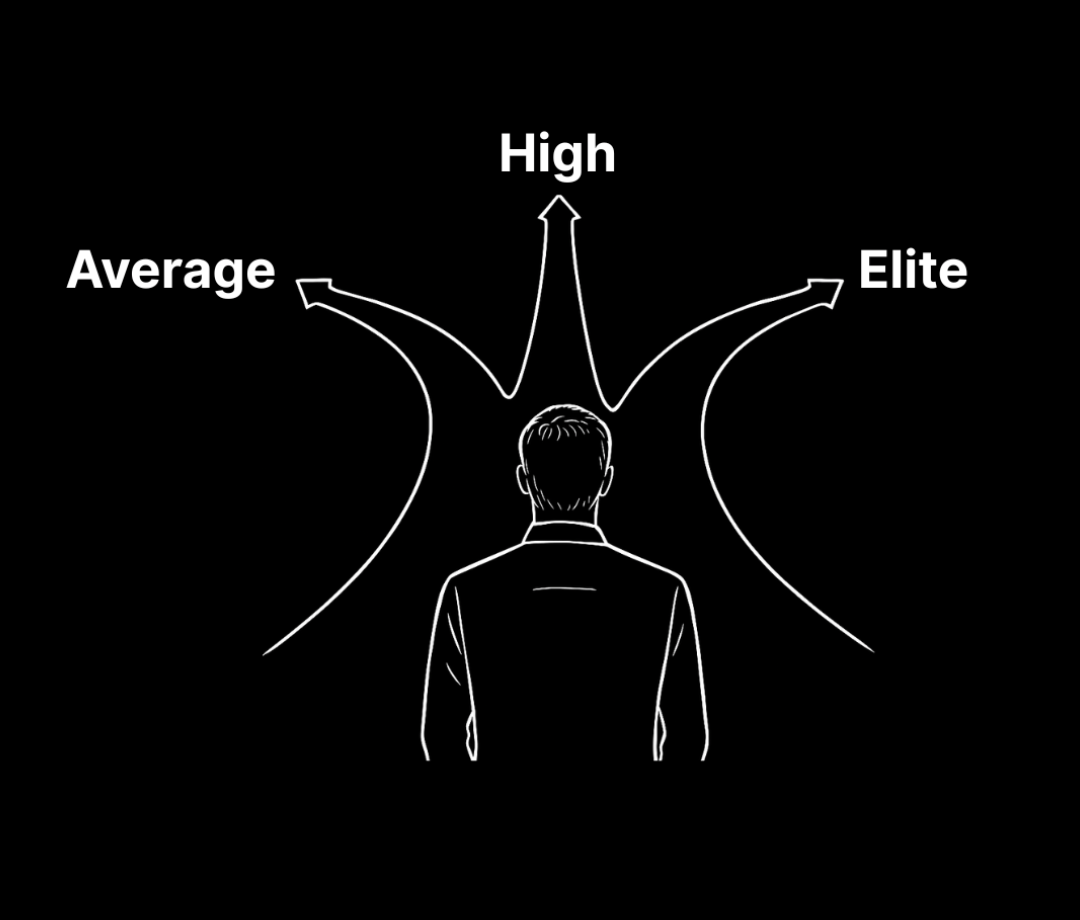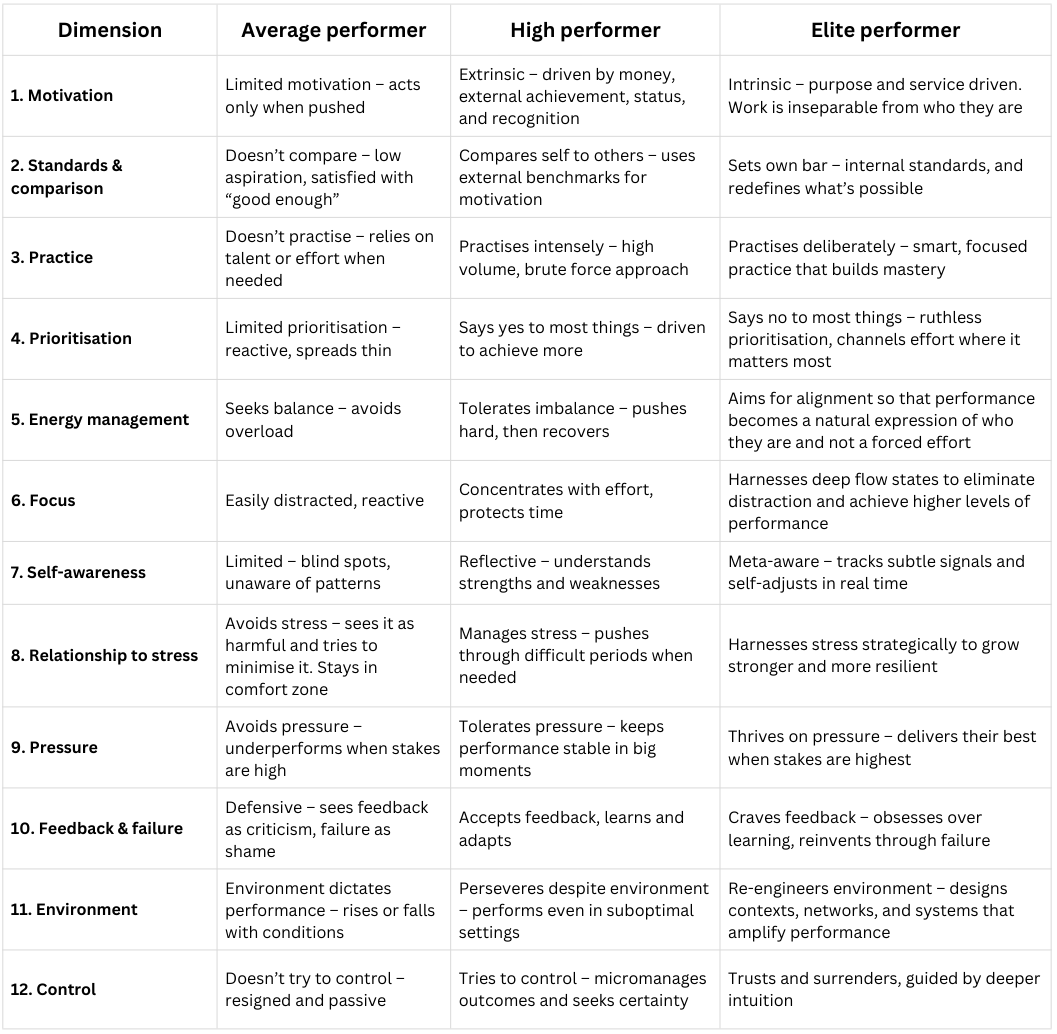Not A Subscriber?
Join a global group of ambitious readers on their quest to understand themselves, life, and business
The hidden rules of elite performers
I’ve always been fascinated by top performers and how they live their lives. From a young age, I tried to emulate them in my own life by studying their routines, testing their practices, and pushing myself to see what was possible. That curiosity only deepened as I moved from university to the world of business consulting and then into writing, sports, and entrepreneurship.
This Perspective is my attempt to share some of the lessons I’ve learnt along the way.
Most people believe elite performers are a different species, born with rare gifts, blessed with luck, or fuelled by endless motivation.
But in reality, what separates them is less about talent and more about orientation. They see the world differently. They practise differently. They relate to stress, failure, and pressure differently.
And because of that, their results compound to levels that look almost unreachable from the outside.
You may not want to win a gold medal or build a trillion-dollar company. And that’s fine. Elite achievement isn’t the only path to a meaningful life.
But by studying what the best do differently, you can extract lessons that matter for your own life. You can take what fits your ambitions and discard the rest. That’s how you build a version of performance that’s aligned to your goals, sustainable, and built on the right foundations.
The three levels of performance
Research shows that truly elite performers are rare, and their contribution isn’t linearly better, it’s exponentially better.
Across almost every field, value creation follows a heavy-tail distribution: a small minority create the vast majority of the impact. For example,
In startups, a few companies drive nearly all the returns in a portfolio.
In software, a handful of engineers deliver multiples more value than the rest of the team.
In trading, only a tiny fraction of traders consistently outperform the rest.
In sports, a Messi, Ronaldo, or Stephen Curry shifts the economics of entire leagues.
In science, a few breakthroughs by a handful of researchers reshape entire fields and society more broadly.
High performers are impressive. They deliver reliably and exceed expectations. But elite performers operate in another category altogether. The difference between them isn’t a small step, it’s a different order of magnitude.
To make this concrete, I’ve broken down performance into three categories (if we disregard under performers):
Average performers – They meet expectations. They do their job, handle what’s asked, and try to avoid failure.
High performers – They exceed expectations. They build habits, manage energy, and achieve goals. They’re consistent, reliable, and valuable.
Elite performers – They don’t just exceed expectations, they redefine them. They shift what others believe is possible, and their impact is transformative.
What elite performance really is
The difference between good and truly elite is rarely a matter of talent alone or even hard work. It’s an orientation toward life - a way of relating to motivation, practice, stress, focus, feedback, and more. Once you shift these foundations, performance stops being something you push for and becomes something you embody.
I want to get practical and break this down into 12 dimensions I’ve observed, lived and coached when it comes to the difference between average, high, and elite performers. What follows is a short description of the 12 dimensions, which are then summarised in a table at the end.
1. Motivation: Average performers have limited motivation and only act when pushed or when circumstances demand it. High performers are extrinsically motivated, fueled by rewards like money, recognition, or status. They are able to push themselves to achieve their goals. Elite performers, on the other hand, have intrinsic motivation: their work is an expression of their identity and purpose, and often tied to service beyond themselves. Rather than needing to push, they feel pulled towards their goals.
2. Standards & comparison: Average performers don’t compare themselves much because they lack aspiration; “good enough” feels sufficient. High performers compare themselves against peers and external benchmarks, constantly trying to measure up. Elite performers set their own bar, measuring themselves against a vision only they can see, and in doing so they often redefine what’s possible for everyone else.
3. Practice: Average performers don’t really practise. They rely on talent, effort, or experience when situations demand it. High performers practise intensely, believing that more hours will equate to more success. Elite performers practise deliberately. They focus on the right details, design feedback loops, get coached or mentored, and make small, compounding adjustments that accelerate their pursuit of mastery (if you’re interested in the topic of deliberate practice, check out the book Peak by Anders Ericsson).
4. Prioritisation: Average performers lack prioritisation and their approach to task management is reactive. High performers try to say yes to most things and take on additional tasks in the pursuit of more achievement, often overloading themselves in the process. Elite performers by definition say no. They are ruthless in focusing on what matters most, channelling their time and energy into the highest-impact activities.
5. Energy management: Average performers seek balance. They avoid pushing themselves too much and suffer when a lot is asked of them. High performers tolerate imbalance. They push hard, burn energy, and then recover when they must. Elite performers aim for alignment, not balance. They design their days, routines, and even their environments to generate energy rather than deplete it, sustaining performance over the long term. When you’re aligned with a deeper purpose, performance becomes a natural expression of who you are and not a forced effort.
6. Focus: Average performers are easily distracted and reactive, pulled in every direction by urgency or convenience. High performers work hard to concentrate, carving out time and effort to protect their focus. Their dominant brainwave frequency is ‘beta’, which leads to high energy but also cognitive overload. Elite performers achieve focus through flow. By harnessing this non-ordinary state of consciousness, they eliminate distraction, achieve a sense of effortless action, and they perceive opportunities and connections that others simply overlook.
7. Self-awareness: Average performers have limited self-awareness. They are often blind to their strengths, weaknesses, and recurring patterns. High performers carve out time for reflection and develop a solid understanding of where they excel and where they fall short. Elite performers develop embodied meta awareness. They can track subtle inner signals, spot their own cognitive and emotional patterns, and adjust their mindsets and behaviours in real-time.
8. Relationship to stress: Average performers avoid stress, seeking comfort and equilibrium. They see stress as harmful and something to be minimised. High performers can tolerate stress and push through difficult periods when the demands are high. Elite performers go further: they harness stress to grow stronger. They use adversity, uncertainty, and ongoing challenges as a training ground, building resilience and capacity over time.
9. Pressure: Average performers avoid pressure, and their performance often dips when the stakes rise. High performers can hold steady under pressure. They don’t collapse, but they also don’t particularly enjoy high stakes moments. Elite performers thrive in pressure moments. When the stakes are highest, they find clarity, sharpen their focus, and often perform at their absolute best.
10. Feedback & failure: Average performers are defensive, interpreting feedback as criticism and failure as a threat to their identity. High performers accept feedback and learn from failure, using it as an opportunity to improve. Elite performers crave feedback and actively seek it out. They obsess over extracting lessons from failure, often reinventing themselves through the process.
11. Environment: Average performers let their environment dictate their performance. They rise or fall depending on conditions. High performers persevere despite their environment, pushing forward even in suboptimal contexts. Elite performers take it further: they re-engineer their environment, deliberately designing contexts, networks, and systems that amplify their performance.
12. Control: Average performers don’t try to control outcomes and are generally quite passive. High performers try to control everything. They micromanage and cling to certainty. Elite performers embrace a paradox: they trust and sense. They surrender control over what cannot be changed, while exerting precise influence over what matters most, guided by intuition and deeper awareness. A striking example comes from elite endurance athletes, which I learned about in the book Running with the Kenyans. Many of the best marathoners and ultrarunners don’t rely heavily on watches or metrics in training. Instead, they cultivate an acute ability to listen to their bodies, tuning into subtle signals of breath, muscle tension, and energy. They pace themselves not by numbers alone but by feel, which is a practice known as running by perceived effort. This allows them to sustain peak performance with greater adaptability and alignment.
These twelve elements show the spectrum of human performance, from average to high to elite. At each step, the mindset, behaviours, and outcomes shift. Average performers often operate reactively, letting external forces shape their work. High performers push harder, chasing external benchmarks and achievements. Elite performers transcend both: they anchor themselves in purpose, aim for inner alignment, and are constantly seeking to reach a bar that only they can see.

The table below summarises these distinctions across all twelve dimensions.

Putting this into practice
You don’t need to tackle all twelve dimensions at once (in fact, you shouldn’t).
Elite performance is the product of years of deliberate refinement. Rather do a few things well than many things poorly.
Here are three practical ways to begin:
1. Choose one dimension to improve. Read through the twelve and ask yourself: Where am I average, where am I good, and where could I shift toward elite? Pick one and experiment for 30 days.
2. Get concrete about what “elite” looks like for you. Define, in detail, what stepping into elite performance would mean in this dimension. Write down the specific actions you’ll take, including what you will do, how you will do it, and when.
3. Build a cadence of reflection. Do the work, and then regularly pause and review. Take a few minutes each day and a longer block each week to reflect on what’s working, what’s not, and what needs to shift. Reflection is how you ensure consistent effort and continuous improvement.
And remember: The leap from high performance to elite performance is not about working harder. It’s about thinking and living differently. Focus as much on the underlying mindset shift you need to embody as the practices on the surface.
Closing thoughts
Elite performers are rare, not because they were born different, but because they chose a different orientation toward life. They lean into challenge rather than retreat from it. They shape their environment instead of being shaped by it. They trust their deeper purpose and let it guide how they show up.
You don’t have to aspire to be in the top 0.1% of your field to benefit from these principles. By studying and adopting them in a way that works for you, you give yourself the chance to live a life that is not only more effective but also more aligned, one where achievement, well-being, and meaning reinforce each other.
Elite performance, in the end, is less about chasing extraordinary results and more about embodying an extraordinary way of being.

About the author Nicolai Nielsen
I am the bestselling author of 3 books, former McKinsey Academy Associate Partner, and the founder of Potential Academy.
My mission is to raise global consciousness through education and inspiration.




